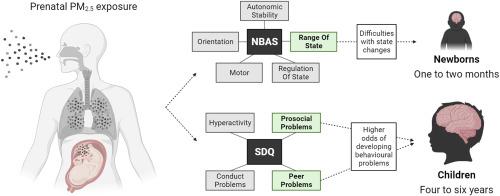当前位置:
X-MOL 学术
›
Environ. Res.
›
论文详情
Our official English website, www.x-mol.net, welcomes your feedback! (Note: you will need to create a separate account there.)
Prenatal particulate matter exposure is linked with neurobehavioural development in early life
Environmental Research ( IF 8.3 ) Pub Date : 2024-04-04 , DOI: 10.1016/j.envres.2024.118879 Charlotte Cosemans , Narjes Madhloum , Hanne Sleurs , Rossella Alfano , Lore Verheyen , Congrong Wang , Kenneth Vanbrabant , Charlotte Vanpoucke , Wouter Lefebvre , Tim S. Nawrot , Michelle Plusquin
Environmental Research ( IF 8.3 ) Pub Date : 2024-04-04 , DOI: 10.1016/j.envres.2024.118879 Charlotte Cosemans , Narjes Madhloum , Hanne Sleurs , Rossella Alfano , Lore Verheyen , Congrong Wang , Kenneth Vanbrabant , Charlotte Vanpoucke , Wouter Lefebvre , Tim S. Nawrot , Michelle Plusquin

|
Early life exposure to ambient particulate matter (PM) may negatively affect neurobehavioral development in children, influencing their cognitive, emotional, and social functioning. Here, we report a study on prenatal PM exposure and neurobehavioral development focusing on different time points in the first years of life. This study was part of the ENVIRAGE birth cohort that follows mother-child pairs longitudinally. First, the Neonatal Behavioral Assessment Scale (NBAS) was employed on 88 newborns aged one to two months to assess their autonomic/physiological regulation, motor organisation, state organisation/regulation, and attention/social interaction. Second, our study included 393 children between the ages of four and six years, for which the Strengths and Difficulties Questionnaire (SDQ) was used to assess the children's emotional problems, hyperactivity, conduct problems, peer relationship, and prosocial behaviour. Prenatal PM exposure was determined using a high-resolution spatial-temporal method based on the maternal address. Multiple linear and multinomial logistic regression models were used to analyse the relationship between prenatal PM exposure and neurobehavioral development in newborns and children, respectively. A 5 μg/m³ increase in first-trimester PM concentration was associated with lower NBAS range of state cluster scores (−6.11%; 95%CI: −12.00 to −0.23%; = 0.04) in one-to-two-month-old newborns. No other behavioural clusters nor the reflexes cluster were found to be associated with prenatal PM exposure. Furthermore, a 5 μg/m³ increment in first-trimester PM levels was linked with higher odds of a child experiencing peer problems (Odds Ratio (OR) = 3.89; 95%CI: 1.39 to 10.87; = 0.01) at ages four to six. Additionally, a 5 μg/m³ increase in second-trimester PM concentration was linked to abnormal prosocial behaviour (OR = 0.49; 95%CI: 0.25 to 0.98; = 0.04) at four to six years old. No associations were found between PM exposure and hyperactivity or conduct problems. Our findings suggest that prenatal exposure to PM may impact neurobehavioural development in newborns and preschool children. We identified sensitive time windows during early-to-mid pregnancy, possibly impacting stage changes in newborns and peer problems and prosocial behaviour in children.
中文翻译:

产前颗粒物暴露与生命早期的神经行为发育有关
生命早期接触环境颗粒物 (PM) 可能会对儿童的神经行为发育产生负面影响,影响他们的认知、情感和社交功能。在这里,我们报告了一项关于产前 PM 暴露和神经行为发育的研究,重点关注生命第一年的不同时间点。这项研究是 ENVIRAGE 出生队列的一部分,该队列纵向跟踪母子对。首先,对 88 名 1 至 2 个月大的新生儿采用新生儿行为评估量表 (NBAS),评估他们的自主/生理调节、运动组织、状态组织/调节以及注意力/社会互动。其次,我们的研究包括 393 名 4 岁至 6 岁的儿童,使用优势和困难问卷(SDQ)评估儿童的情绪问题、多动症、品行问题、同伴关系和亲社会行为。使用基于母亲地址的高分辨率时空方法确定产前 PM 暴露。采用多元线性和多项logistic回归模型分别分析产前PM暴露与新生儿和儿童神经行为发育之间的关系。妊娠早期 PM 浓度增加 5 μg/m3 与一到两个月内较低的 NBAS 州聚类得分范围相关(−6.11%;95%CI:−12.00 至 −0.23%;= 0.04)高龄新生儿。没有发现其他行为簇或反射簇与产前 PM 暴露相关。此外,孕早期 PM 水平增加 5 μg/m3 与 4 至 6 岁儿童遇到同伴问题的几率较高有关(优势比 (OR) = 3.89;95% CI:1.39 至 10.87;= 0.01) 。此外,妊娠中期 PM 浓度增加 5 μg/m3 与 4 至 6 岁时的异常亲社会行为有关(OR = 0.49;95% CI:0.25 至 0.98;= 0.04)。没有发现颗粒物暴露与多动或行为问题之间存在关联。我们的研究结果表明,产前接触 PM 可能会影响新生儿和学龄前儿童的神经行为发育。我们确定了怀孕早期到中期的敏感时间窗口,可能会影响新生儿的阶段变化以及儿童的同伴问题和亲社会行为。
更新日期:2024-04-04
中文翻译:

产前颗粒物暴露与生命早期的神经行为发育有关
生命早期接触环境颗粒物 (PM) 可能会对儿童的神经行为发育产生负面影响,影响他们的认知、情感和社交功能。在这里,我们报告了一项关于产前 PM 暴露和神经行为发育的研究,重点关注生命第一年的不同时间点。这项研究是 ENVIRAGE 出生队列的一部分,该队列纵向跟踪母子对。首先,对 88 名 1 至 2 个月大的新生儿采用新生儿行为评估量表 (NBAS),评估他们的自主/生理调节、运动组织、状态组织/调节以及注意力/社会互动。其次,我们的研究包括 393 名 4 岁至 6 岁的儿童,使用优势和困难问卷(SDQ)评估儿童的情绪问题、多动症、品行问题、同伴关系和亲社会行为。使用基于母亲地址的高分辨率时空方法确定产前 PM 暴露。采用多元线性和多项logistic回归模型分别分析产前PM暴露与新生儿和儿童神经行为发育之间的关系。妊娠早期 PM 浓度增加 5 μg/m3 与一到两个月内较低的 NBAS 州聚类得分范围相关(−6.11%;95%CI:−12.00 至 −0.23%;= 0.04)高龄新生儿。没有发现其他行为簇或反射簇与产前 PM 暴露相关。此外,孕早期 PM 水平增加 5 μg/m3 与 4 至 6 岁儿童遇到同伴问题的几率较高有关(优势比 (OR) = 3.89;95% CI:1.39 至 10.87;= 0.01) 。此外,妊娠中期 PM 浓度增加 5 μg/m3 与 4 至 6 岁时的异常亲社会行为有关(OR = 0.49;95% CI:0.25 至 0.98;= 0.04)。没有发现颗粒物暴露与多动或行为问题之间存在关联。我们的研究结果表明,产前接触 PM 可能会影响新生儿和学龄前儿童的神经行为发育。我们确定了怀孕早期到中期的敏感时间窗口,可能会影响新生儿的阶段变化以及儿童的同伴问题和亲社会行为。



























 京公网安备 11010802027423号
京公网安备 11010802027423号